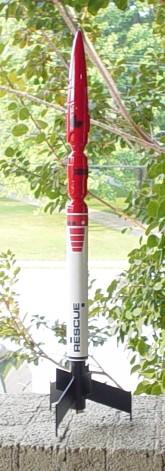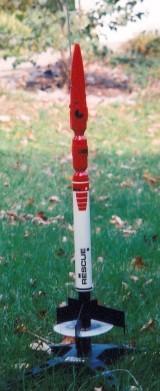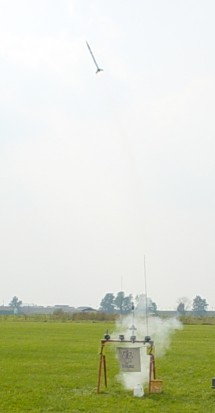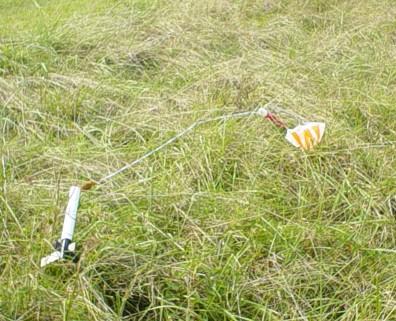| Construction Rating: | starstarstarstarstar |
| Flight Rating: | starstarstarstarstar |
| Overall Rating: | starstarstarstarstar |
| Manufacturer: | Estes  |
| Skill Level: | 2 |
| Style: | Futuristic/Exotic |

Brief:
From a personal standpoint, the most regrettable error I made in the '80s had
nothing to do with parachute pants or a Flock Of Seagulls haircut, but rather
with giving my rockets away to the younger brothers of one of my college
friends. Twenty-odd years down the road I found that it was possible to
recreate all but one of these early kits by cloning them, the Estes Odyssey
being the exception to that rule. Originally produced from 1977 to 1982, the
Odyssey has a large, stylized nose cone that makes up more than half of the
total height of the rocket. Since this nose cone was only ever used on one
other production rocket, the equally seldom seen Rigel 3, there aren't a glut
of them to be found on the aftermarket. It was pretty obvious that my only
option was to find a built Odyssey and restore it or buy and build a vintage
kit. While I've never seen a built Odyssey or Rigel 3 for sale, the kits
occasionally pop up on the auctions, which is where I found my Odyssey after a
lengthy search.
Construction:
- BT-55IJ main body tube (9" length)
- BT-20DJ engine mount tube (4" length)
- BT-50EE fin mount tube (5.5" length)
- PNC-55CB nose cone
- EH-2 18mm engine hook
- HR-20 engine hook retainer ring
- AR-2050S split adapter ring
- 2 AR-5055 adapter rings
- 12" Kevlar® shock cord
- Small piece of Perma Wadding
- 36" sewing elastic shock cord (1/8" width)
- 3/32" balsa fin stock
- 2 3/16" launch lug (standoff made from scrap balsa)
- Wood dowel 1/8" X 6"
- Fin pattern sheet
- 18" parachute
- Decals

While it is definitely exotic looking, the Odyssey isn't a terribly difficult project, as evidenced by the skill level two rating that it merited back in 1977. I found that the building and finishing process can be made significantly easier by doing it in three sections instead of two. I began with the lowermost portion which houses the engine mount and to which the fins are mounted. (I'd like to take a moment to say how nice it is to build an Estes kit with the old style engine hook instead of the new monstrosity.) The bottom section was built according to the instructions with the exception of the engine block, which was modified to strengthen the recovery system ala 2003. I added a length of Kevlar® thread to act as the shock cord anchor, knotted behind the engine block and secured with a heavy coat of wood glue. When combined with an extra long length of sewing elastic to act as a shock cord, the chances of shock cord failure or the nose cone rebounding into the body tube are greatly reduced.
With the only construction necessary on the middle section of the Odyssey being the attachment of the launch lug and standoff, the finishing stage is upon you almost before you know it. I used the obligatory two coats of thinned Elmer's Fill 'n' Finish to fill the tube spirals and seal the balsa, sanding between each coat, then applied two coats of Valspar Primer. After another round of sanding, I slipped a piece of scrap BT-55 over the centering rings that allow the lower section to mate to the middle section, then sprayed the lower section with Valspar Gloss Black. The scrap BT-55 keeps the paint from building up on the centering rings and makes the process much easier when the time comes to put the two sections together for real. Special care should be taken to ensure paint coverage on the bottom of the rearmost centering ring because this will be a part of this section that will be visible when the assembly is finished. The center section needs only to be sprayed with two coats of Valspar Gloss White to ready it for assembly. The nose cone was in pretty decent shape right out of the package with very little in the areas of seams or flash to take care of. Once I had done the minimal cleanup, I sprayed the cone with a coat of Valspar white primer, then two coats of Valspar Gloss Cherry Red and it looked great. The red, white, black color scheme accentuates the size of the nose cone and it even looks great without the decals, but it looks REALLY great with the decals. Since the decals that came with the kit were badly yellowed and brittle, I chose to make a new set of my own using the scans on JimZ's site. They looked great when I printed them, bright and bold, but faded somewhat after I sprayed them with a protective clearcoat. When I applied them, the fading in the red areas of the decal became even more pronounced, enough so that I chose to make another set to double up the red. This turned out great, and while not exactly a cost-effective solution, it is a good way to make the decals opaque again as opposed to semi-opaque. (I've since found that using lacquer based clear instead of an acrylic based clear also makes a difference.)
Construction Rating: 5 out of 5

Flight:
On it's only flight to date, I was surprised by the reaction that the Odyssey
caused as I took it to the pads. Several people commented on the "weird,
sci-fi thing" that I was carrying and seemed genuinely confused when I
told them it was an old Estes kit. Despite the oddball nose cone they thought
it was an original design that I had dreamed up for something that I had found
and rigged for use as a nose cone. The first flight was made without decals,
which could be blamed for the reaction, but several of my fellow fliers seemed
unaware that the Odyssey was ever kitted by Estes. (I've since found that this
is not an unusual reaction. The Odyssey was apparently not a terribly popular
rocket in it's day, despite it's cover shot on the 1977 catalog.)
The first flight was nerve-racking, if for no other reason than the relatively heavy investment I had made in an almost irreplaceable old kit. (Irreplaceable might be too strong a word, but I doubt that lightning would strike twice and let me pick another one up at the price I had walked off with this one.) Flying on a C6-5, the Odyssey weathercocked slightly in the light breeze, but the boost was impressive and the gently curving flight path only made the recovery that much closer to the pad.
Recovery:
I had been worried about the possibility of the recovery system getting tangled
on the dowels that tipped the rear fins, but the extra length shock cord made
that a non-issue. Recovery was impressive with the whole rocket stretching out
to nearly five feet as it floated gently into the patch of tall weeds that line
our field. The weeds have been crisscrossed with paths cut by the mowers and I
followed one of these paths to a point close to where I thought the Odyssey
might have landed. One step into the weeds proved me correct. There the Odyssey
sat, stretched out and draped over the vegetation only a few feet off the path.
All of my recoveries should be that easy.

Flight Rating: 5 out of 5
Summary:
In addition to being a great looking rocket, the Odyssey is also guaranteed to
be one of the more seldom seen vintage rockets at the pads on any given launch
day. Along with the Andromeda, U.S.S. Atlantis, and Satellite Interceptor, the
Odyssey was one of the great unsung futuristic kits of the late '70's Estes
catalogs. Seldom seen, but stylish almost to a fault, a vintage Odyssey is
definitely worth the trouble of tracking down and building. Just don't expect
it to be cheap.
PROs:
- Not many of these around.
- Extremely unique nose cone. (I sent my nose cone to Mike Schmidt at Moldin' Oldies to see if he could make a resin reproduction, but the cone's length and intricate surface details prevented him from being able to get a serviceable copy.)
- Relatively simple build.
- Not many of these around.
- Extremely unique nose cone.
- Relatively high price for an original kit.
Overall Rating: 5 out of 5
 |
 |
Flights
 |
 |
Sponsored Ads
 |
 |












Jeff Curtis (September 16, 2023)
Bad Boy Rocketry now sells a clone of this kit.